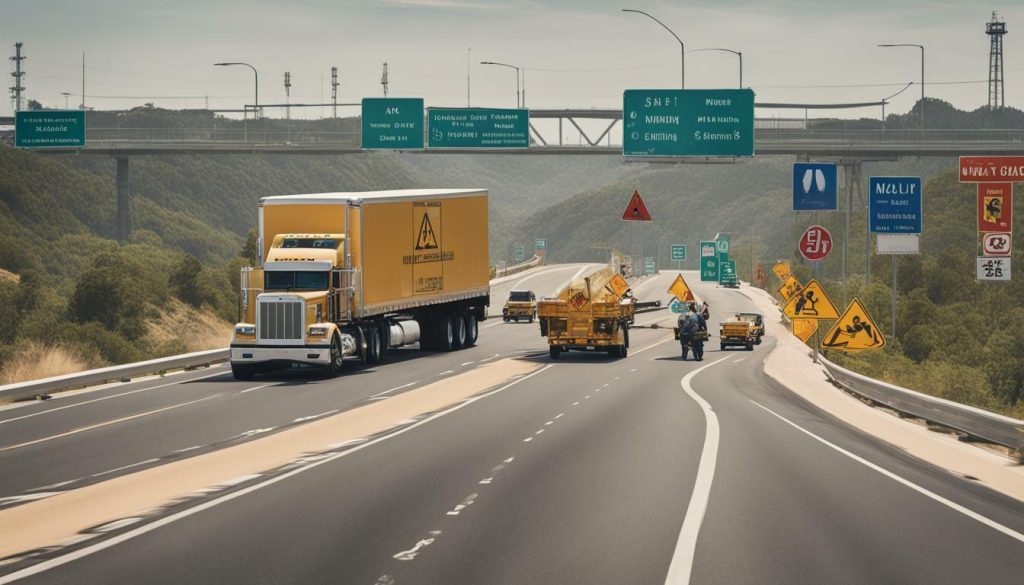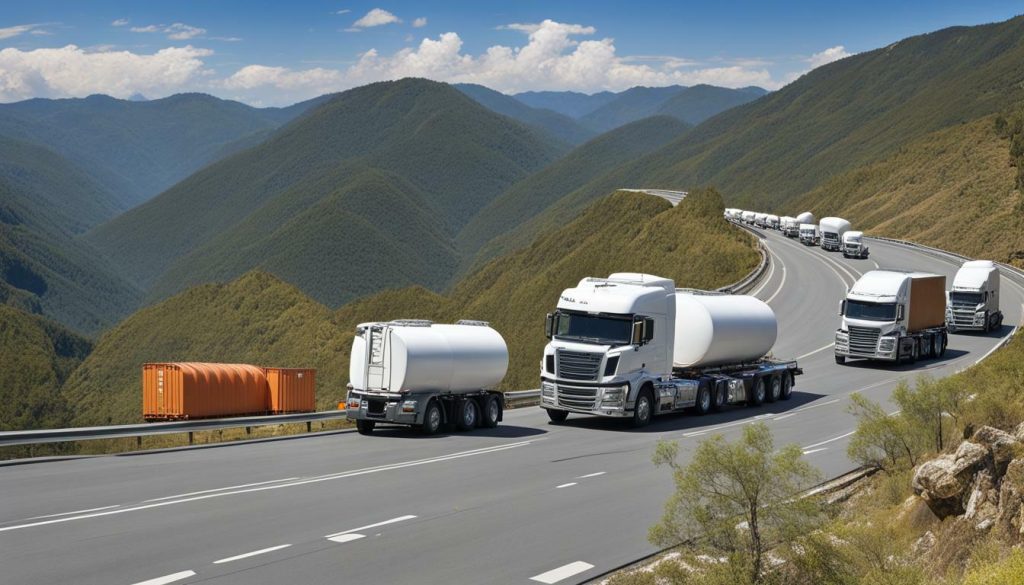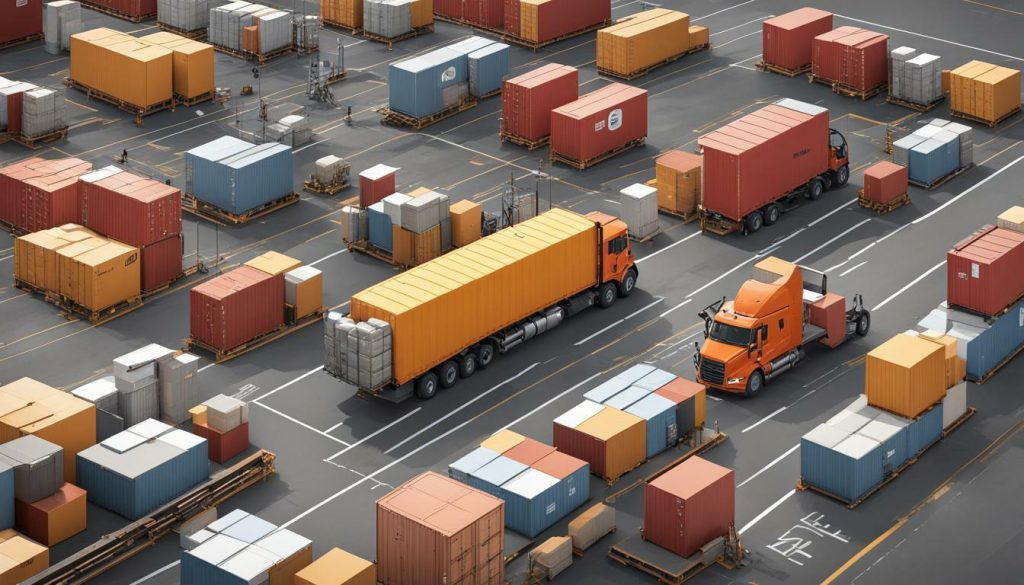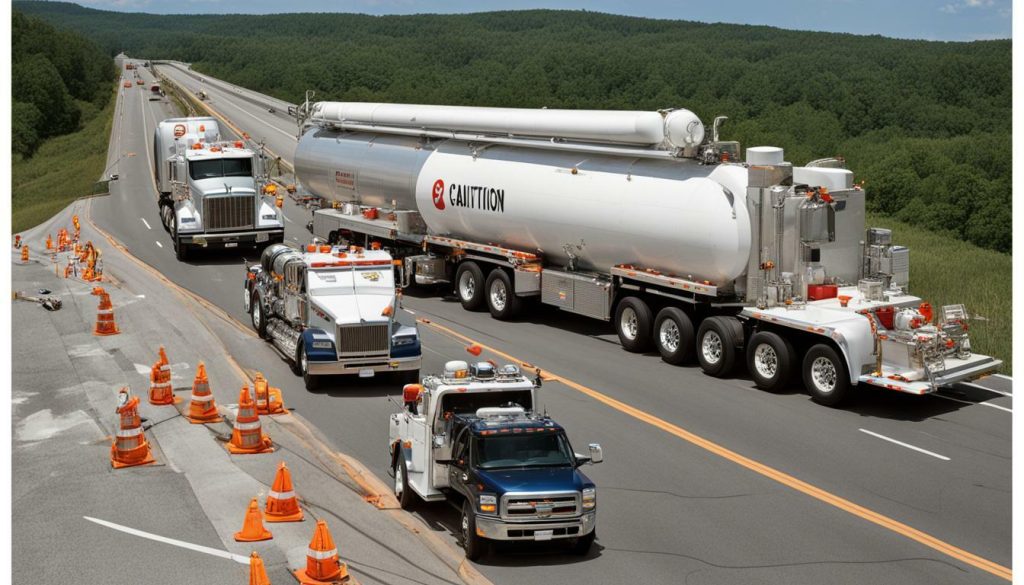Managing the transport of hazardous materials is a crucial part of ensuring the safety of your business and the environment. Hazardous materials transport logistics involves the planning, execution, and control of the movement of dangerous goods. It requires a high level of expertise and attention to detail to minimize risks and comply with regulations.
Transport logistics for hazardous materials involves various aspects, including selecting appropriate packaging, identifying risks and hazards, and implementing effective handling procedures. All these aspects must be integrated into an efficient and well-planned strategy that ensures the safe and timely delivery of goods.
Key Takeaways
- Hazardous materials transport logistics is critical in safeguarding your business and the environment.
- It involves the planning, execution, and control of the movement of dangerous goods.
- Proper risk assessment, handling procedures, and emergency preparedness are essential components of effective hazardous materials transport logistics.
Table of Contents
Understanding Hazardous Materials Transport Regulations
Transporting hazardous materials requires adherence to strict regulations to ensure safety and maintain compliance. These regulations govern every aspect of hazardous materials transport logistics, including packaging, labeling, and documentation.
As a business owner or logistics manager, it is your responsibility to stay up-to-date on the latest hazardous materials transport regulations to protect your employees, customers, and the environment. The United States Department of Transportation (DOT) enforces these regulations through its Pipeline and Hazardous Materials Safety Administration (PHMSA), which oversees the safe transportation of hazardous materials.
The PHMSA’s Hazardous Materials Regulations (HMR) provide the framework for hazardous materials transport logistics in the United States. These regulations define hazardous materials and outline specific requirements for packaging, labeling, and documentation. Additionally, the HMR establishes training requirements for employees involved in hazardous materials transport logistics.
Failure to comply with hazardous materials transport regulations can result in significant fines and legal consequences. In addition to financial penalties, non-compliance can also lead to accidents and environmental damage.

To ensure compliance with hazardous materials transport regulations, it is important to establish and maintain a comprehensive hazardous materials management program. This program should include ongoing employee training, regular equipment maintenance, and a thorough understanding of the regulations that govern hazardous materials transport logistics.
Understanding the Hazardous Materials Table
The Hazardous Materials Table is a critical resource for anyone involved in hazardous materials transport logistics. This table provides important information about specific hazardous materials, including proper shipping names, hazard classes, and packaging requirements.
When transporting hazardous materials, it is crucial to consult the Hazardous Materials Table to ensure compliance with packaging, labeling, and documentation requirements. The table also provides information about special provisions and exceptions that apply to specific hazardous materials.
The Importance of Hazardous Materials Training
Proper training is essential for anyone involved in hazardous materials transport logistics. The HMR requires that all employees involved in hazardous materials transport receive adequate training before beginning work.
Training should cover a range of topics, including the proper handling and storage of hazardous materials, emergency response procedures, and compliance with hazardous materials transport regulations. Ongoing training is also necessary to ensure that employees stay up-to-date on the latest regulations and best practices.
Conclusion
Understanding and adhering to hazardous materials transport regulations is crucial for the safety of employees, customers, and the environment. By following established regulations and best practices, businesses can ensure that hazardous materials are transported safely and legally.
Assessing Hazardous Materials Risks and Hazards
As you manage hazardous materials transport logistics, it’s crucial to assess the risks and hazards associated with their transportation. Proper hazardous materials handling begins with a comprehensive risk assessment to identify potential hazards and minimize risks.
A hazardous materials management plan must contain a detailed analysis of the types of materials being transported, the quantity being transported, and the potential risks associated with each material. Hazardous materials handling also requires implementation of proper precautions to ensure safe transportation and handling.
It’s recommended that you work with a team of experts to conduct the risk assessment, as they can offer invaluable knowledge and insights into the transportation of hazardous materials. A thorough understanding of hazardous materials transport logistics and the associated risks is necessary to implement effective safety measures and prevent accidents.

During the assessment process, it’s crucial to identify any potential emergencies that may occur during transportation and develop an emergency response plan to mitigate any risks. The emergency response plan must include procedures for safely disposing of any hazardous materials and protecting personnel and the environment.
By assessing hazardous materials risks and hazards, you can develop effective hazardous materials management strategies while complying with regulatory requirements. Failure to do so may result in severe consequences, including environmental damage, injuries, and regulatory fines.
Selecting Appropriate Packaging and Containers
When it comes to hazardous materials transport logistics, selecting the right packaging and containers is crucial in ensuring safe and compliant transportation. The materials being transported, as well as the mode of transportation, will determine the specific packaging and container requirements.
Hazardous materials management regulations require that containers and packaging must meet certain specifications to ensure they can withstand the rigors of transport without compromising safety. Some of these requirements include material compatibility, leak-proof design, and adequate labeling for identification purposes.
| Container Type | Advantages | Disadvantages |
|---|---|---|
| Drums | Sturdy, stackable, and available in various sizes. | Heavy and difficult to move, potential for damage during transport. |
| Intermediate Bulk Containers (IBCs) | Can hold large volumes, easy to handle and transport. | More expensive than drums, requires special handling for disposal. |
| Flexible Containers | Can fit into tight spaces, lightweight, and can hold large volumes. | May not be suitable for all materials, potential for tearing or puncture during transport. |
Hazardous materials handling procedures must also be considered when selecting the appropriate packaging and containers. Proper loading, unloading, and storage procedures can minimize the risk of accidental spills or leaks.
Remember to consult with hazardous materials transport logistics experts and regulatory agencies to ensure compliance with all packaging and container requirements. By selecting the right packaging and containers, you can minimize safety risks during transport and safeguard your business and the environment.

Implementing Effective Hazardous Materials Handling Procedures
Proper handling of hazardous materials during transport is crucial to ensure the safety of both individuals involved in the transport process and the environment. Here are some best practices to follow when handling hazardous materials:
Loading and Unloading Procedures
When loading hazardous materials onto a transport vehicle, ensure that the vehicle is clean and free from any incompatible materials. The materials should be properly secured to prevent any movement during transport, and labels and markings should be clearly visible.
During unloading, take caution to avoid spills or leaks. Use appropriate equipment, such as pumps and funnels, to transfer the materials to the designated storage area.
Storage Procedures
Proper storage is essential to maintain the integrity of hazardous materials during transport. The materials should be stored in a location that is suitable for their specific properties and hazards, such as temperature and ventilation requirements. Labels and markings should be visible at all times, and incompatible materials should be stored separately to prevent any potential reactions.
Personal Protective Equipment
Individuals involved in the handling of hazardous materials should always wear appropriate personal protective equipment (PPE) to minimize their exposure to the materials. Depending on the specific hazard, PPE may include gloves, goggles, respirators, or full-body suits. Regular training on the proper use and maintenance of PPE is essential to ensure its effectiveness.
Emergency Procedures
In the event of an emergency, such as a spill or leak, having a well-planned and practiced emergency response plan can minimize the impact and prevent further harm. All individuals involved in the transport process should be trained on the proper emergency procedures, including evacuation routes and the use of emergency equipment such as spill kits and fire extinguishers.

By following these best practices for hazardous materials handling during transport, you can ensure the safe and effective transport of hazardous materials. Remember to always prioritize safety and adhere to regulatory requirements and compliance measures.
Addressing Emergency Preparedness and Response
Despite the best efforts to prevent accidents, hazardous materials transportation can still pose risks to people and the environment. That’s why it is critical to have a well-planned and practiced emergency preparedness and response plan in place.
Your plan should start with an assessment of the potential hazards that may arise during transportation. This will help you identify the necessary emergency response equipment and measures that need to be implemented.
Training your employees on emergency response procedures is also crucial. They should know how to handle emergencies, including how to evacuate, contact emergency services, and mitigate risks.
Additionally, make sure that your emergency response plan is regularly reviewed, updated, and tested. This will help you identify any gaps in your plan and make the necessary adjustments to ensure it remains effective.
Remember, effective hazardous materials management is not just about prevention but also about effective emergency response. By having a well-planned and practiced emergency preparedness and response plan, you can minimize risks and protect people and the environment.

Conclusion
In conclusion, effective hazardous materials transport logistics is critical for safeguarding businesses, communities, and the environment. As a responsible business owner, it is your duty to ensure compliance with hazardous materials transport regulations and implement best practices for risk assessment, packaging and container selection, and handling procedures. Emergency preparedness and response plans should also be in place to minimize potential accidents and mitigate risks.
By focusing on these key areas of hazardous materials management, you can ensure the safe transport of hazardous materials and protect both your business and the wider community from the potential harm of hazardous materials. Remember, hazardous materials transport logistics should always be a top priority for any business that deals with these materials. Stay compliant, stay safe, and protect your business and the environment from the potential risks of hazardous materials transport logistics.
FAQ
Q: What is hazardous materials transport logistics?
A: Hazardous materials transport logistics refers to the planning, coordination, and management of the transportation process for hazardous materials in a safe and compliant manner.
Q: Why is hazardous materials transport logistics important?
A: Hazardous materials transport logistics is crucial for safeguarding businesses and the environment. It ensures that hazardous materials are handled, packaged, and transported safely, minimizing the risk of accidents, spills, and environmental contamination.
Q: What regulations govern hazardous materials transport?
A: Hazardous materials transport is regulated by various governmental bodies, such as the Department of Transportation (DOT) in the United States. These regulations outline the requirements for classifying, packaging, labeling, and documenting hazardous materials for transport.
Q: How can businesses comply with hazardous materials transport regulations?
A: To comply with hazardous materials transport regulations, businesses must ensure that their shipments meet all the necessary requirements. This includes using appropriate packaging, labeling the materials correctly, and providing proper documentation, such as shipping papers and emergency response information.
Q: Why is risk assessment important in hazardous materials transport logistics?
A: Risk assessment helps businesses identify potential hazards and evaluate the risks associated with transporting hazardous materials. By understanding these risks, businesses can implement appropriate safety measures, such as selecting suitable routes, using secure packaging, and providing training for employees.
Q: How do businesses select appropriate packaging and containers for hazardous materials transport?
A: When selecting packaging and containers for hazardous materials transport, businesses must consider the characteristics of the materials being transported, such as their compatibility and potential for leakage or damage. They should choose packaging that meets the regulatory requirements and provides sufficient protection during transportation.
Q: What are some best practices for handling hazardous materials during transport?
A: Best practices for handling hazardous materials during transport include proper loading, securing, and unloading procedures. It is essential to follow established protocols, use appropriate equipment and personal protective equipment, and ensure that employees are trained in handling hazardous materials safely.
Q: How can businesses prepare for emergencies during hazardous materials transport?
A: Businesses should develop and implement emergency preparedness and response plans for hazardous materials transport. These plans should include procedures for addressing spills, leaks, fires, and other incidents. Regular training, communication, and coordination with emergency response agencies are also essential.


